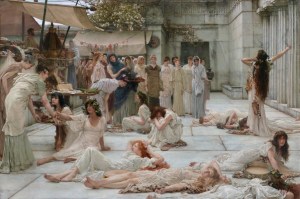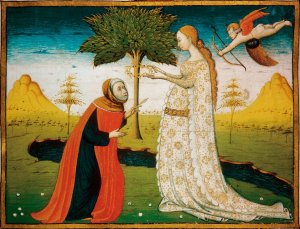We support our Publishers and Content Creators. You can view this story on their website by CLICKING HERE.
Perhaps the greatest of national anthems is France’s “La Marseillaise,” composed in 1792 by French officer Claude Joseph Rouget de Lisle, and arranged by Hector Berlioz for voices and orchestra in 1830. But in addition to the official anthems of the world’s nations, there are, of course, many other musical works that embody the spirit of their composers’ countries. In an era of resurgent nationalism, it seems timely to present ten of the greatest of these “unofficial” national anthems.
1. Bedřich Smetana: Má Vlast (My Fatherland)
Czech composers of the late nineteenth and early twentieth centuries embraced the spirit of nationalism, and Bedřich Smetana’s monumental cycle of tone poems about his native Bohemia is surely unsurpassed as the greatest single nationalistic work ever composed. Lasting some seventy minutes, the work is comprised of six movements: 1. “Vyšehrad” (“The High Castle”), whose opening harp solo sets a mood of nostalgia for the mighty Bohemian past; 2. “Vltava,” paints a vivid picture of the mighty river that flows through Prague and the Bohemian countryside; 3. Šárka tells the story of the legendary female warrior who leads an uprising of women against men; 4. “Z českých luhů a hájů” (“From Bohemia’s Woods and Fields”) depicts the beauty of the Bohemian countryside; 5. “Tábor” takes its name from the Bohemian city founded by the Hussites and honors the struggle of these Christian dissidents; 6. Blaník is the name of a mountain, which according legend, houses an army of knights that will rise up to defend the Czech nation in its most desperate hour.
2. Dvořák: My Home
Czech composer Antonín Dvořák, one of the great masters of melody, wrote the tuneful Czech Suite about his beloved Bohemia, as well as this overture, My Home, which was part of the incidental music for a play. Dvořák incorporated into the overture melodies from two folksongs, including the song “Where is my home?,” which became the Czech national anthem.
3. Johann Strauss, Jr.: On the Beautiful Blue Danube
Though in the form of a waltz, Johann Strauss Jr.’s immortal Blue Danube is nothing less than a ten-minute tone poem about his beloved Vienna.
4. Beethoven: Germania
Ludwig van Beethoven originally dedicated his Third Symphony, the famous “Eroica,” to Napoleon, but, disenchanted when the Frenchman proclaimed himself Emperor, the composer famously ripped the dedication from the cover of the score. A decade later, Beethoven, caught up in the German nationalist spirit sweeping Vienna with the allied victory over Napoleonic France, composed music for the final scene of a patriotic opera, called Die Gute Nachricht (The Good News). Germania celebrates the work of Prussian King Frederick William III and Emperor Francis of Austria in defeating Napoleon and uniting the German princes:
Germania, Germania,
Thou stand′st before us formidably.
Whenever German courage is called German and free,
Gratitude shall be expressed for Frederick William.
He was firm like a wall of iron.
He shall be praised, Hail to thee, Germania….Germania, Germania,
How dost thou stand forever and ever.
What desire thought in every individual,
Who brought it together?
Francis, Emperor Francis – Victory!
He shall be praised, and Hail to thee, Germania.
5. Respighi: Roman Festivals
Italian composer Ottorino Respighi wrote this noisy piece, the last of the tone poems of his “Roman trilogy” (the others being “Fountains of Rome” and “Pines of Rome”) in 1928. It portrays scenes from his adopted city’s past and present and is divided into four sections: “Circuses” depicts the gladiatorial games and the sacrificing of Christians in the Circus Maximus; “Jubilee” portrays the journey of medieval Christian pilgrims to the Holy City; “October Festival” dramatizes the dancing, hunting, and singing at harvest season; “Epiphany” captures the mood of celebration among revelers in Rome’s Piazza Navona on the eve of the Christian feast.
6. Sibelius: Finlandia
Easily his most famous composition, composer Jean Sibelius wrote this piece in 1899-1900 to stir patriotism among his fellow Finns, as they chafed under the domination of the Russian Empire. The original version, called “Finland Awakens,” was the sixth part of a suite of music Sibelius wrote for a tableau-drama on Finnish history, the occasion being the annual Press Celebrations. Beginning in a spirit of foreboding, Finlandia transitions mid-way into a heroic call to arms, ending with a hymn-like tune that Sibelius fashioned into a separate patriotic piece. The versions below include the lyrics (translated into English) that were appended to the piece and accepted by Sibelius: The first version being the full tone poem, the second version being an a cappella hymn fashioned by Sibelius.
Finland, behold, thy daylight now is dawning,
the threat of night has now been driven away.
The skylark calls across the light of morning,
the blue of heaven lets it have its way,
and now the day the powers of night is scorning:
thy daylight dawns, O Finland of ours!
Finland, arise, and raise towards the highest
thy head now crowned with mighty memory.
Finland, arise, for to the world thou criest
that thou hast thrown off thy slavery,
beneath oppression’s yoke thou never liest.
Thy morning’s come, O Finland of ours!
7. Borodin: In the Steppes of Central Asia
Alexander Borodin wrote this piece in 1880 to accompany one scene of a living tableau of scenes of Russian history and life during the silver jubilee celebrations of the rule of Tsar Alexander II. In the Steppes of Central Asia a caravan moving across the plains under the protection of Russian troops. Though the Tsar cancelled the anniversary festivities due to an assassination attempt on his life, Borodin’s short and evocative piece quickly became a concert favorite and has remained popular ever since.
8. Bizet: La Patrie
Georges Bizet composed this concert overture to celebrate France’s role in the Franco-Prussian War.
9. Vianna da Motta: Symphony À Pátria
One of the last students of Franz Liszt, the Portuguese composer José Vianna da Motta was, like his teacher, a distinguished piano virtuoso. À Pátria, his only symphony, was inspired by verses from Os Lusíadas, the epic poem by Luís Vaz de Camões, which tells of the Portuguese voyages of discovery of the fifteenth and sixteenth centuries.
10. De Falla: Nights in the Gardens of Spain
Originally written for solo piano, Spanish composer Manuel de Falla orchestrated Noches en los Jardines de España for piano and orchestra in 1915, calling it a series of “symphonic impressions.” It is divided into three sections: “Generalife,” which describes the gardens of the summer palace of Alhambra; “Danza Lejana” (“A Distant Dance”), evoking an exotic dance in an unspecified garden; “En los jardines de la Sierra de Córdoba” (“In the Gardens of the Sierra de Córdoba”), which paints a scene of gypsy dancing.
This essay was first published here in February 2017.
The Imaginative Conservative applies the principle of appreciation to the discussion of culture and politics—we approach dialogue with magnanimity rather than with mere civility. Will you help us remain a refreshing oasis in the increasingly contentious arena of modern discourse? Please consider donating now.
The featured image is “Rouget de Lisle chantant la Marseillaise” by Isidore Pils. It is in the public domain and appears here courtesy of Wikimedia Commons.

 Conservative
Conservative  Search
Search Trending
Trending Current News
Current News 






